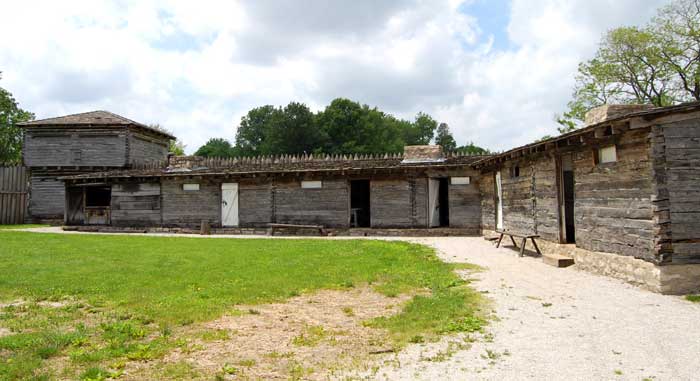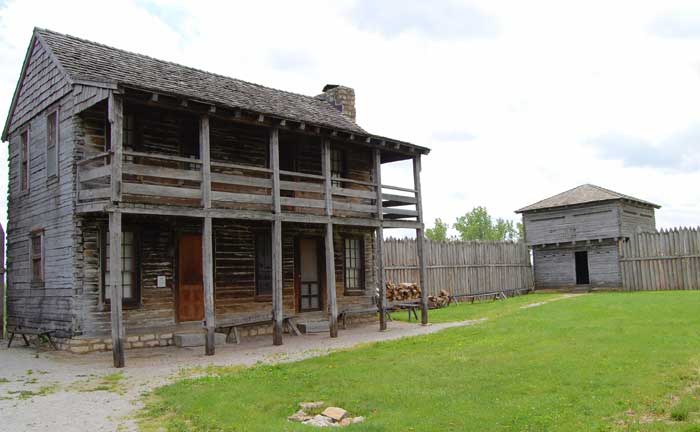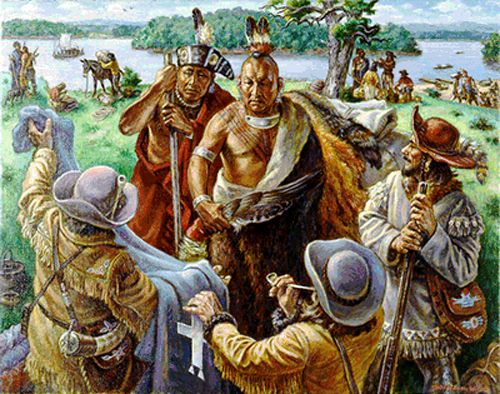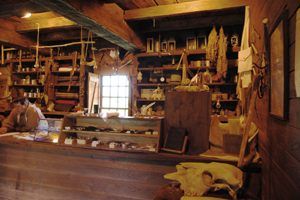Fort Osage, Missouri Trading Post – Legends of America (original) (raw)
Fort Osage, Sibley, Missouri by Kathy Alexander.
Fort Osage, located in present-day Sibley, Missouri, was one of three forts established by the U.S. Army to establish control over the newly acquired territory of the Louisiana Purchase. Also known as Fort Clark or Fort Sibley, the site served as a trading post.
Lewis and Clark passed through the area of Fort Osage in present-day Missouri in June 1804 on their journey west to the Pacific Ocean. Clark considered this spot to be a good place for a fort with its “high commanding position, more than 70 feet above high-water mark and overlooking the river, which is here but of little depth.”

Lewis and Clark
Upon their return in 1806, Meriwether Lewis was named governor, and William Clark was given the post of commander of the militia and Indian agent of the Louisiana Territory. Clark established Fort Osage, one of the first military outposts in the Louisiana Purchase, in 1808 to protect and promote trade with the Osage Indians.
The fort was built by the men of the 1st Regiment, U.S. Infantry, who traveled in six keelboats up the Missouri River under the command of Captain Eli Clemon and the St. Charles Dragoons, who marched overland under Clark’s command. Four of the keelboats carried $20,000 worth of merchandise belonging to George C. Sibley, who was the chief factor, or trader, at the post.
A vital part of the success of the “factory” was the trader’s access to the river where incoming and outgoing goods were received and dispatched. Sibley built his factory to have access to the river through his second basement. Remnants of the Ferry Road are included in the Fort Osage District.
Osage traders by Charles Banks Wilson, courtesy of the artist
It is believed that two of the most significant treaties in the history of Missouri were signed at the Fort between the Osage Indians and the U.S. Government. On September 14, 1808, the Osage ceded all of their lands east of a line running south of the Fort to the Arkansas River. A later treaty, signed on November 14 of the same year, further granted to the U.S. all of the Osage land claims north of the Missouri River, while the annuity for the cessions was established at $1,000.00 for the Great Osage Tribe, and half that amount for the Little Osage tribe.

Fort Osage, Missouri by Kathy Alexander.
Fort Osage quickly became one of the most successful of the 28 government-supervised trading posts that functioned from 1795 to 1822. These operated under a “factory” system intended to prevent the exploitation of American Indians by individual traders.
The fort was closed during the War of 1812 and was re-garrisoned in 1815. Until 1819, when the garrison was moved to Council Bluffs, Iowa, Fort Osage was the westernmost fortified outpost of the U.S. Government’s Factory system. In 1822, the trading house was closed due to the government’s abandonment of the factory trading system.
In 1825, Fort Osage also became the point from which distances were measured on the Santa Fe Trail. Westward migrants stopped at Fort Osage as it was the last servicing point on their journey. Remnants of the Santa Fe Trail are still seen in the District today.
Nothing remains of the original buildings at the site; however, the old fort was rebuilt in 1951 utilizing the same timbers and building materials used by early pioneers of Jackson County and rests upon its original foundation. Reconstruction of the fort was based on archaeological evidence found at the site and from a drawing of the fort by William Clark.
The trading post-factory is one-and-one-half stories high with two cellars below. One of the lower cellars opens to the river bluff for river access. The first floor is reconstructed as the factor’s residence and a trading post museum. Besides the factory, the site presently includes a main blockhouse, four blockhouses at the corners of the post stockade; officer quarters, soldiers barracks, and remaining service buildings, all constructed between 1951-1961. In 1965 soldiers’ huts and a stockade fence were added, completing the reconstruction of the fort area.
Fort Osage, Sibley, Missouri by Kathy Alexander.
More Information:
Fort Osage
107 Osage Street
Sibley, Missouri 64088
(816) 650-5737 or (816) 650-3278
Compiled and edited by Kathy Alexander/Legends of America, updated February 2022.
Also See:
Forts Across the United States (list)
George C. Sibley – Surveyor of the Santa Fe Trail
Sources:


